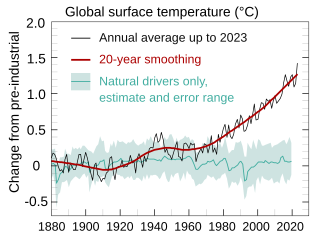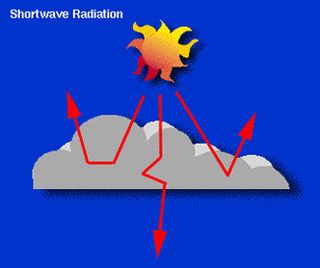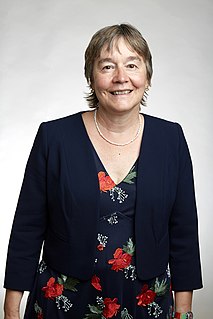
Attribution of recent climate change is the effort to scientifically ascertain mechanisms responsible for recent global warming and related climate changes on Earth. The effort has focused on changes observed during the period of instrumental temperature record, particularly in the last 50 years. This is the period when human activity has grown fastest and observations of the atmosphere above the surface have become available. According to the Intergovernmental Panel on Climate Change (IPCC), it is "extremely likely" that human influence was the dominant cause of global warming between 1951 and 2010. Likely human contribution is 93%–123% of the observed 1951–2010 temperature change.

The greenhouse effect is the process by which radiation from a planet's atmosphere warms the planet's surface to a temperature above what it would be without this atmosphere.
Global warming potential (GWP) is the heat absorbed by any greenhouse gas in the atmosphere, as a multiple of the heat that would be absorbed by the same mass of carbon dioxide (CO2). GWP is 1 for CO2. For other gases it depends on the gas and the time frame. Some gases, like methane, have large GWP, since a ton of methane absorbs much more heat than a ton of CO2. Some gases, again like methane, break down over time, and their heat absorption, or GWP, over the next 20 years is a bigger multiple of CO2 than their heat absorption will be over 100 or 500 years. Values of GWP are estimated and updated for each time frame as methods improve.

Svante August Arrhenius was a Swedish scientist. Originally a physicist, but often referred to as a chemist, Arrhenius was one of the founders of the science of physical chemistry. He received the Nobel Prize for Chemistry in 1903, becoming the first Swedish Nobel laureate. In 1905, he became director of the Nobel Institute, where he remained until his death.

Cloud forcing is, in meteorology, the difference between the radiation budget components for average cloud conditions and cloud-free conditions. Much of the interest in cloud forcing relates to its role as a feedback process in the present period of global warming.

Radiative forcing or climate forcing is the difference between insolation (sunlight) absorbed by the Earth and energy radiated back to space. Changes to Earth's radiative equilibrium, that cause temperatures to rise or fall over decadal periods, are called climate forcings. Positive radiative forcing means Earth receives more incoming energy from sunlight than it radiates to space. This net gain of energy will cause warming. Conversely, negative radiative forcing means that Earth loses more energy to space than it receives from the sun, which produces cooling. A system in thermal equilibrium has zero radiative forcing.
This glossary of climate change is a list of definitions of terms and concepts relevant to climate change, global warming, and related topics.

Earth's energy budget accounts for the balance between the energy that Earth receives from the Sun, and the energy the Earth radiates back into outer space after having been distributed throughout the five components of Earth's climate system and having thus powered Earth’s so-called heat engine. This system is made up of Earth's water, ice, atmosphere, rocky crust, and all living things.
The IPCC Third Assessment Report (TAR), Climate Change 2001, is an assessment of available scientific and socio-economic information on climate change by the IPCC. The IPCC was established in 1988 by the United Nations Environment Programme (UNEP) and the UN's World Meteorological Organization (WMO) "... to assess scientific, technical and socio-economic information relevant for the understanding of climate change, its potential impacts and options for adaptation and mitigation." The Third Assessment Report is the third of a series of assessments; it has been superseded by the IPCC Fourth Assessment Report (AR4), released in 2007.

Roger A. Pielke Sr. is an American meteorologist with interests in climate variability and climate change, environmental vulnerability, numerical modeling, atmospheric dynamics, land/ocean – atmosphere interactions, and large eddy/turbulent boundary layer modeling. He particularly focuses on mesoscale weather and climate processes but also investigates on the global, regional, and microscale. Pielke is an ISI Highly Cited Researcher.

Climate sensitivity is a measure of how much the Earth's climate will cool or warm after a change in the climate system, for instance, how much it will warm for doubling in carbon dioxide concentrations. In technical terms, climate sensitivity is the average change in the Earth's surface temperature in response to changes in radiative forcing, the difference between incoming and outgoing energy on Earth. Climate sensitivity is a key measure in climate science, and a focus area for climate scientists, who want to understand the ultimate consequences of anthroprogenic climate change.
A runaway greenhouse effect occurs when a planet's atmosphere contains greenhouse gas in an amount sufficient to block thermal radiation from the planet, preventing the planet from cooling and from having liquid water on its surface. The runaway greenhouse effect can be defined by a limit on a planet's outgoing longwave radiation which is asymptotically reached due to higher surface temperatures boiling a condensable species into the atmosphere, increasing its optical depth. This runaway positive feedback means the planet cannot cool down through longwave radiation and continues to heat up until it can radiate outside of the absorption bands of the condensable species.
Ian Enting is a mathematical physicist and the AMSI/MASCOS Professorial Fellow at the ARC Centre of Excellence for Mathematics and Statistics of Complex Systems (MASCOS) based at The University of Melbourne.
This is a list of climate change topics.

Veerabhadran Ramanathan is Edward A. Frieman Endowed Presidential Chair in Climate Sustainability Scripps Institution of Oceanography, University of California, San Diego. He has contributed to many areas of the atmospheric and climate sciences including developments to general circulation models, atmospheric chemistry, and radiative transfer. He has been a part of major projects such as the Indian Ocean Experiment (INDOEX) and the Earth Radiation Budget Experiment (ERBE), and is known for his contributions to the areas of climate physics, Climate Change and atmospheric aerosols research. He is now the Chair of Bending the Curve: Climate Change Solutions education project of University of California. He has received numerous awards, and is a member of the US National Academy of Sciences. He has spoken about the topic of global warming, and written that "the effect of greenhouse gases on global warming is, in my opinion, the most important environmental issue facing the world today."
The surface of the Sun radiates light and heat at approximately 5,500 °C. The Earth is much cooler and so radiates heat back away from itself at much longer wavelengths, mostly in the infrared range. The idealized greenhouse model is based on the fact that certain gases in the Earth's atmosphere, including carbon dioxide and water vapour, are transparent to the high-frequency, high-energy solar radiation, but are much more opaque to the lower frequency infrared radiation leaving the surface of the earth. Thus heat is easily let in, but is partially trapped by these gases as it tries to leave. Rather than get hotter and hotter, Kirchhoff's law of thermal radiation says that the gases of the atmosphere also have to re-emit the infrared energy that they absorb, and they do so, also at long infrared wavelengths, both upwards into space as well as downwards back towards the Earth's surface. In the long-term, thermal equilibrium is reached when all the heat energy arriving on the planet is leaving again at the same rate. In this idealized model, the greenhouse gases cause the surface of the planet to be warmer than it would be without them, in order for the required amount of heat energy finally to be radiated out into space from the top of the atmosphere.

A greenhouse gas (sometimes abbreviated GHG) is a gas that absorbs and emits radiant energy within the thermal infrared range. Greenhouse gases cause the greenhouse effect on planets. The primary greenhouse gases in Earth's atmosphere are water vapor (H
2O), carbon dioxide (CO
2), methane (CH
4), nitrous oxide (N
2O), and ozone (O3). Without greenhouse gases, the average temperature of Earth's surface would be about −18 °C (0 °F), rather than the present average of 15 °C (59 °F). The atmospheres of Venus, Mars and Titan also contain greenhouse gases.

Heaven and Earth: Global Warming – The Missing Science is a popular science book published in 2009 and written by Australian geologist, professor of mining geology at Adelaide University, and mining company director Ian Plimer. It disputes the scientific consensus on climate change, including the view that global warming is "very likely due to the observed increase in anthropogenic (man-made) greenhouse gas concentrations" and asserts that the debate is being driven by what the author regards as irrational and unscientific elements.

Gabriele Clarissa Hegerl is Professor of Climate System Science at the University of Edinburgh School of GeoSciences. Prior to 2007 she held research positions at Texas A&M University and at Duke University's Nicholas School of the Environment, during which time she was a co-ordinating lead author for the Intergovernmental Panel on Climate Change (IPCC) Fourth and Fifth Assessment Report.










